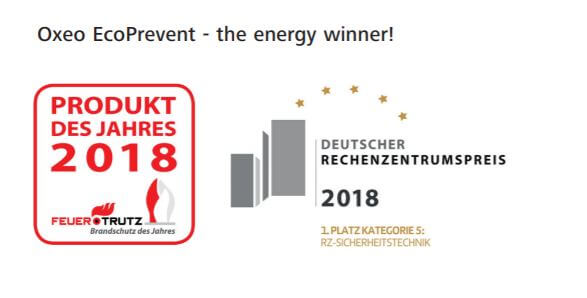EcoPrevent Oxygen Reduction System
EcoPrevent Oxygen Reduction System
WHAT AN ECOPREVENT OXYGEN REDUCTION SYSTEM IS
INTRODUCTION
When we are concerned about safety in fire protection and are used to traditional protection systems, we inevitably ask ourselves “if a fire occurs, will my systems extinguish it?” With the inert systems of EcoPrevent, PEFIPRESA, with the expertise of Minimax, this thought has no place.
What the EcoPrevent inertization systems are?
Oxeo EcoPrevent systems use nitrogen to offer energy-efficient fire protection at the highest level of safety. They actively eliminate fires by reducing oxygen. Oxeo EcoPrevent systems stand for reliability, flexibility and efficiency, making them the perfect solution when dealing with fire protection of particularly sensitive areas.
Oxeo EcoPrevent systems use an oxygen-reduced atmosphere to ensure constant fire protection. Operational downtimes are reduced to a minimum and environmental and property damage from fire or its consequences is eliminated. The ability to deliver irretrievable goods is optimally protected.
Depending on the system, the oxygen concentration in the protected area is either continuously low or if required in an emergency lowered via the controlled supply of nitrogen. An open fire cannot break out. In addition, the spread of a smouldering fire is reduced to a minimum. Unlike reactive firefighting via extinguishing systems or fire departments, Oxeo EcoPrevent systems exclude fires from the outset by using oxygen reduction. The use of nitrogen avoids the consequences of fire damage from the extinguishing agent. Such consequences can sometimes occur with water-based suppression systems if the water damages sensitive components.
Products creating toxic reaction from extinguishing agents and burning material are also avoided, for example in warehouses used for the storage of hazardous substances.
Oxeo EcoPrevent systems can be used wherever conventional firefighting solutions are difficult or impossible. This is often the case in areas that are difficult to access or in refrigeration applications. Compared with gas extinguishing systems, in Oxeo EcoPrevent systems the oxygen concentration always remains at a safe constant level for people due to the regulated and controlled feed of nitrogen. In the case of gas extinguishing systems on the other hand, the oxygen concentration continuously increases again after flooding due to leakage points in the room. This means that the power supply to the protected area must be preventively switched off again after a few minutes in order to prevent reigniting.
How oxygen reduction works
Certain conditions have to be met for a fire to ignite. If flammable material, ignition energy and oxygen are in the right ratio to one another, a fire can break out at any time. Generally it is very difficult to remove all flammable material out of an area that needs to be protected, or to eliminate all potential ignition sources.
On the other hand the oxygen concentration can be selectively lowered. Natural ambient air has an oxygen content of almost 21 % vol. The Minimax Oxeo EcoPrevent fire protection systems lower the ambient oxygen content in the protected area by the deliberate supply of nitrogen to the point where an open fire cannot even develop.
If the relevant ignition limits of the flammable materials are not known, Minimax establishes these in practical trials and determines the necessary level of reduction. PEFIPRESA, with the expertise of MINIMAX’s fire prevention systems offers a bespoke fire protection design that can then be implemented for the application.
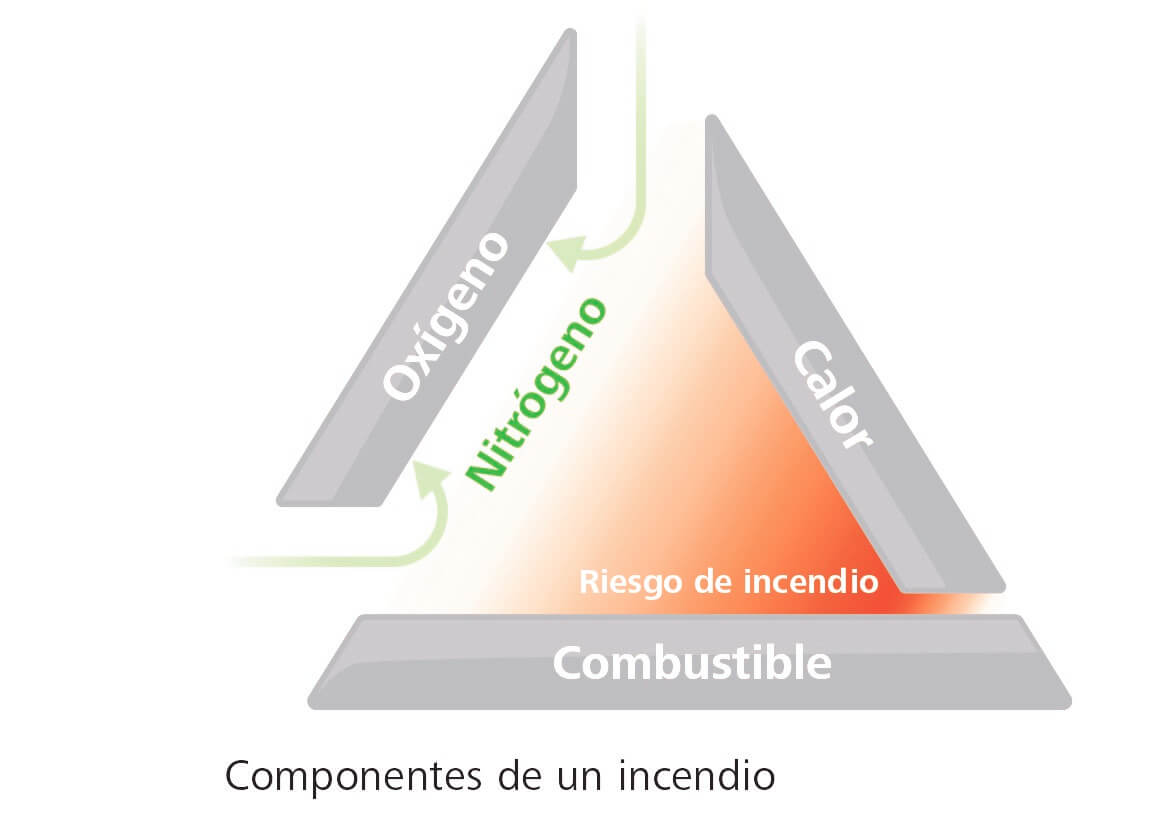
Depending on the fire prevention system, the “fireproof atmosphere” is built up either permanently preventively or as required. All versions of the Oxeo EcoPrevent product family can be combined, and use the next generation of economically efficient nitrogen generators.
Thanks to Oxeo EcoPrevent, protected areas remain accessible and can be used with hardly any restrictions. At normal atmospheric pressure the nitrogen ratio is completely harmless and non-toxic. As nitrogen is present at 78% volume in the natural atmosphere, the human body is adapted to a high nitrogen ratio in the air. The reduction of the oxygen ratio to 15% achieved by an Oxeo EcoPrevent system corresponds roughly to the absolute oxygen ratio compared to an altitude of 3,000 meters above sea level.
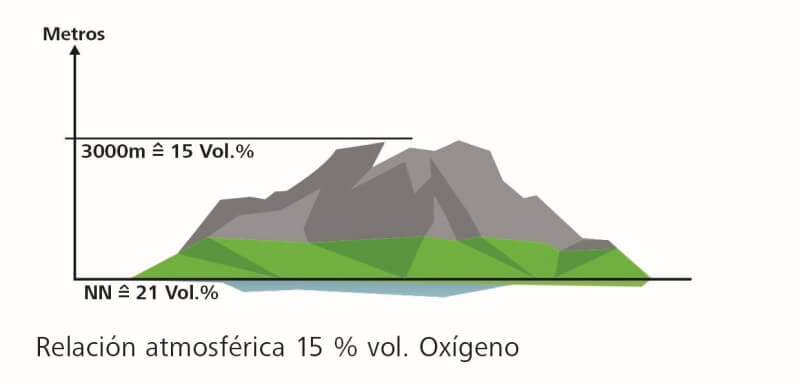
Construction and function – simply efficient
In structure and function Oxeo EcoPrevent fire prevention systems are particularly energy-efficient. For the continual provision of nitrogen, depending on the version, they require less or even no electrical energy in comparison with conventional oxygen reduction systems.
In Oxeo EcoPrevent fire prevention systems, oxygen sensors permanently monitor the current oxygen content in the area to be protected. If the oxygen concentration rises, for example via an unintentional entry of ambient air, the sensors send a signal to the FMZ 5000 EcoPrevent control panel. The control panel immediately activates the nitrogen feed, and oxygen-reduced air arrives via a pipe system into the areas to be protected until the pre-set and homogeneous concentration is reached.
The oxygen-reduced atmosphere is indicated, and the current oxygen value is digitally displayed via illuminated panels on the access doors. Access to the protected area continues to be possible for authorized personnel.
Use of a Helios smoke aspiration system provides extra safety. It actively takes air samples from the protected zone and analyses them in a measurement chamber. This means that even the smallest smouldering fires are detected even earlier.
All Oxeo EcoPrevent fire prevention systems consist of a nitrogen source, control panel, the protected area with oxygen sensors, alarm devices and pipe system for feeding in the oxygen-reduced air.
With regards to the type of nitrogen sources used, the Minimax fire prevention systems are divided into the Oxeo EcoPrevent FC version with fuel cell, the Oxeo EcoPrevent VG version with VPSA nitrogen generator, and the Oxeo EcoPrevent CS with cylinder batteries. In addition to this it is possible to combine various versions that are individually tailored to customer needs.
PEFIPRESA, led by the expertise of MINIMAX, provides well-designed installation and maintenance solutions for these types of risk.
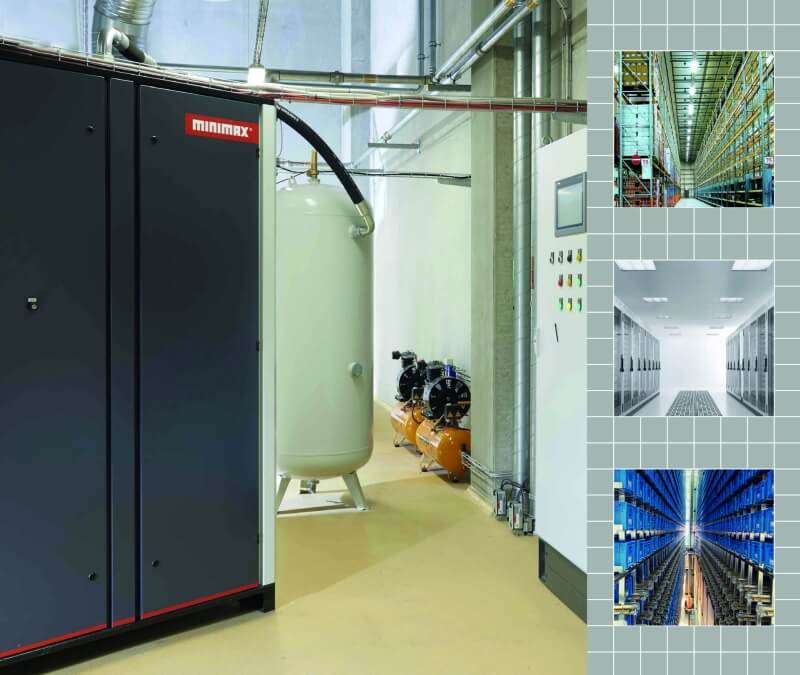
VERSIONES OXEO ECOPREVENT
Oxeo EcoPrevent VG
The VPSA nitrogen generating system works on the pressure change principle. Containers filled with granular carbon separate the oxygen and thus reduce the oxygen content in the air. The granular carbon consists of specially treated active carbon which enables the separation of oxygen and nitrogen.
The compressed ambient air enters an adsorption tank via an energy-efficient low-pressure compressor.
The tank contains the granular carbon which retains the smaller oxygen molecules from the air in its pores. The nitrogen can thus flow past and is thereby separated from the oxygen. One cycle lasts approx. 60 seconds and includes the nitrogen separation in a tank (adsorption) and the removal by vacuum pump of the bound oxygen in a second tank (resorption).
As this process is continuously, alternately repeating itself, nitrogen is permanently available for introduction into the protected area.
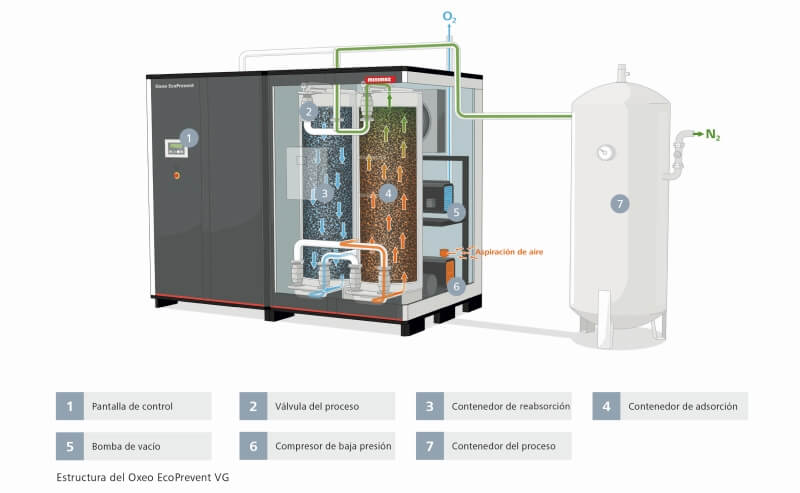
Thanks to low process pressures the VPSA nitrogen reduction system is very energy-efficient. The reduction of system pressure immediately leads to an effective lowering of energy consumption. In direct comparison with conventional oxygen reduction systems the energy costs can be reduced by up to 70%. In addition to this, the lower process pressure protects the components and granular carbon, thereby reducing component wear.
The scalable design allows individual quantities to be supplied. From quantities upwards, the modular design offers built-in partial redundancy. If a module is being serviced or is possibly completely out of service, part of the quantity supplied will still be available. Often this is sufficient to maintain fire protection or if necessary to gain enough time to restore complete fire protection.
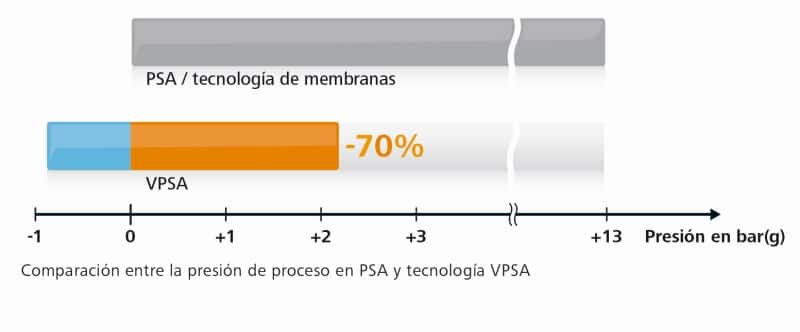
The modest dimensions of the VPSA make it possible to implement the entire oxygen reduction system as a container solution. This saves valuable space in buildings.
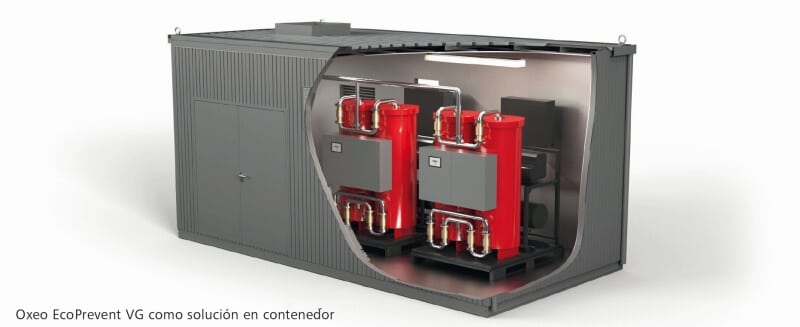
Oxeo EcoPrevent FC (Fuel Cell)
Conventional oxygen reduction systems require a pneumatic air compressor, a compressed air conditioner and a nitrogen generator in order to continually reduce the oxygen content. This creates running costs which after just a few years may be higher than the original investment.
Significantly more economical is the exclusive combination of a fuel cell system from Minimax’s partners Fuji N2telligence. In a similar manner to motorized cogeneration units, fuel cells simultaneously generate power and heat on the basis of the cogeneration principle. This process is almost silent, and thanks to the direct conversion of chemical energy from the gas used it is very efficient.
During energy generation the fuel cell produces clean and nitrogen-rich exhaust air as a by-product. During operation this exhaust air is continuously created without any extra costs and can ideally be used for the operation of an oxygen reduction system for fire prevention.
In addition to this the power generated can significantly reduce the conventional volume of electricity purchased or alternatively be used as an emergency power supply. The hot water produced in the fuel cell can be integrated into the heating system, linked into production processes or converted to low temperature by the use of adsorption systems.
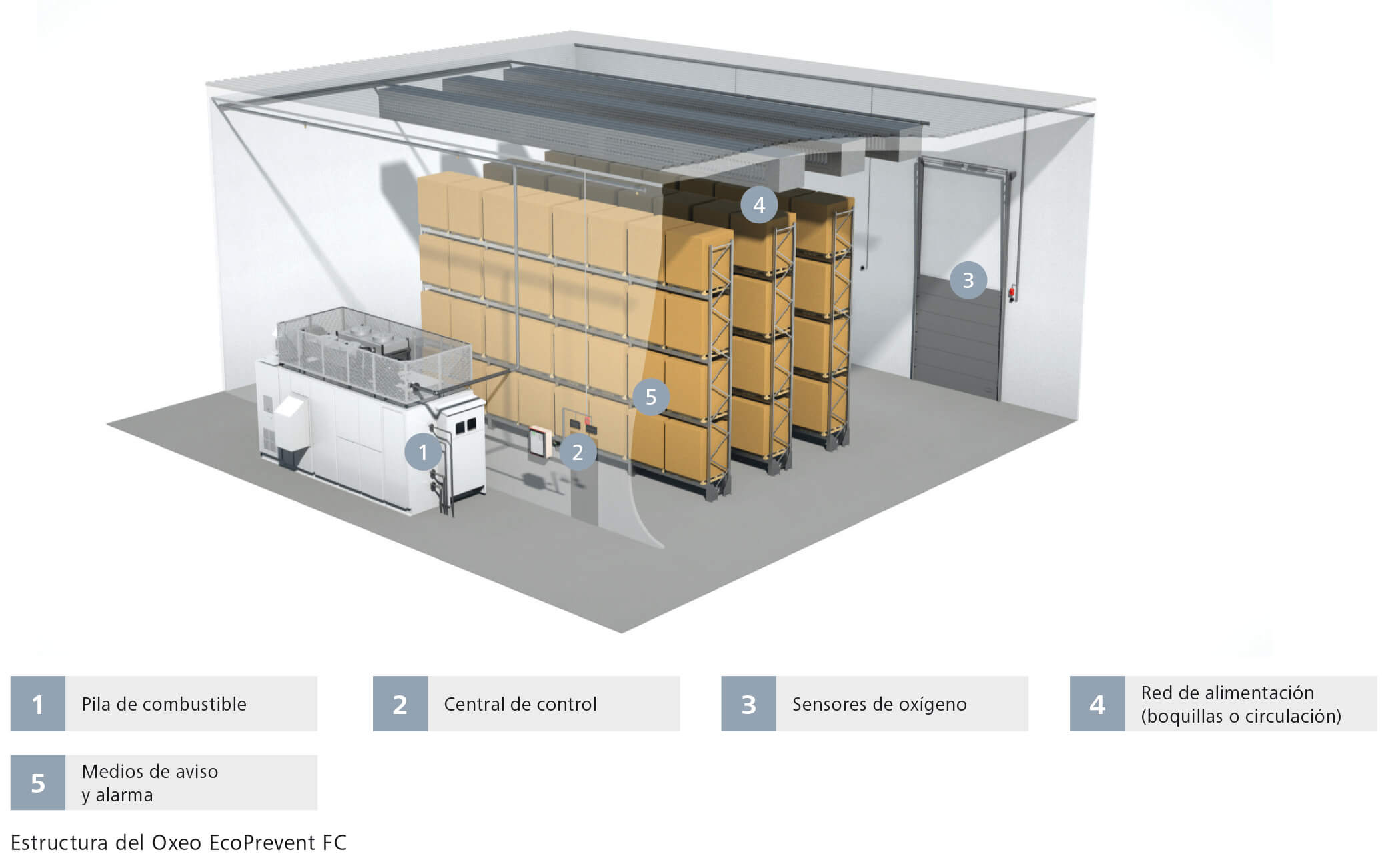
When converting natural gas to electrical and thermal energy, fuel cells achieve more than 90% efficiency and annually save hundreds of tonnes of CO2. And since there is no motor running in the fuel cell, only chemical processes, the technology is particularly low-maintenance.
Combined with the innovative fuel cell technology, the Oxeo EcoPrevent FC fire prevention system offers an extremely efficient solution. Depending upon the level of utilization, a return on investment can be reached and even a profit generated after just a few years.
Oxeo EcoPrevent CS (Cylinder Storage)
When a fire breaks out, thermolysis gases escape even before aerosols or smoke particles are created. The Oxeo EcoPrevent CS system detects these thermolysis gases in good time and lowers the oxygen concentration in the protected area by a controlled feed of nitrogen to the point that a “fire-proof atmosphere” is created. It switches into “prevention mode”.
In the protected areas, the oxygen concentration is measured continuously by appropriate sensors, and their data, is then, transmitted to the EcoPrevent CS FMZ 5000 control panel. The controlled allocation of inert gas takes place on the basis of the oxygen concentration recorded. In this way, in prevention mode, and for particular events, the intervention mode can be maintained for a given defined period of time in consultation with the operator. This gives the desired time in an emergency to maneuver to localize and resolve the cause of the thermolysis gas emission. This avoids having to turn off the air conditioning and working IT systems – a benefit in view of the high availability requirements of data centers.
For an unusually strong spread of fire, for example one caused by a short circuit or high-energy electric arc, aspirating smoke detectors detect the smallest aerosols or smoke particles and the system goes into “intervention mode”: A further supply of nitrogen creates an atmosphere sufficient to put out a fire. So by switching over to intervention mode it allows the system to extinguish a fire in the same way as an inert gas extinguishing system would do.
In Oxeo EcoPrevent CS the inert gas is stored in cylinder batteries. This applies to the change to prevention mode and if necessary to intervention mode and to the tracking of the oxygen concentration defined in both of these functional conditions. The on/off cylinder valves developed by Minimax are optimized for flow and guarantee a reliable control of the inert gas flow corresponding to the relevant signals from the control panel.
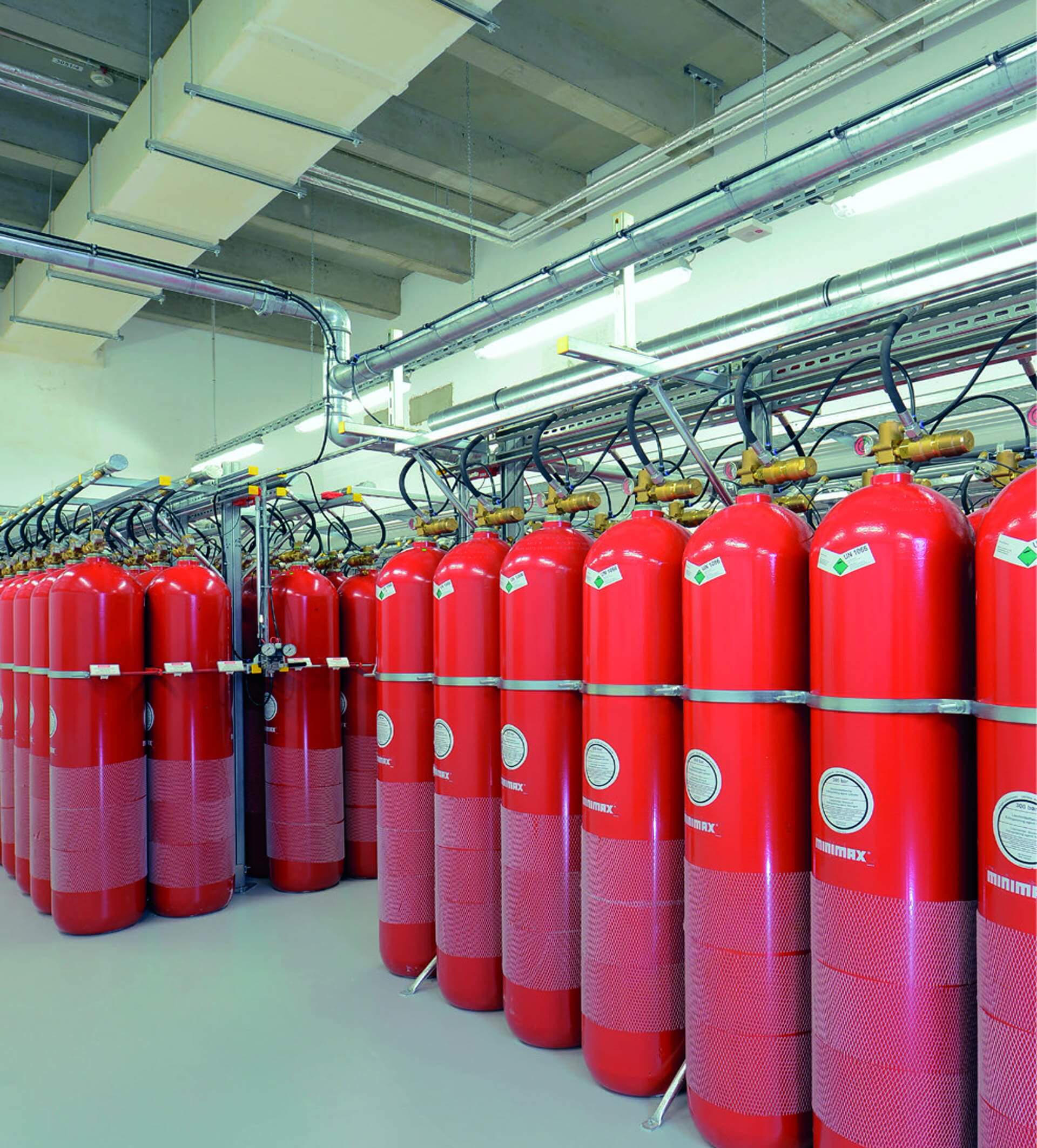
Oxeo EcoPrevent CS incurs almost no energy costs, in contrast to systems with constant oxygen reduction. The protected areas are only supplied with inert gas when necessary, i.e. when thermolysis gases are detected. On-site production of the inert gas by means of compressors, compressed air conditioning and nitrogen generators is unnecessary. Due to the modularity of cylinder batteries the inert gas supply can easily expand alongside extensions to the protected area. This makes it the more flexible solution in comparison with compressors and nitrogen generators.
In standby operation, areas protected by Oxeo EcoPrevent CS are freely accessible, since the natural oxygen concentration is only reduced when required. Occupational safety examinations of personnel remaining in areas with an oxygen concentration above 17% vol. are unnecessary. It can even be readily used in spaces with permanent workstations. The protection area concerned needs to be vacated only when the Oxeo EcoPrevent CS system switches from standby mode to prevention mode following the detection of thermolysis gas.
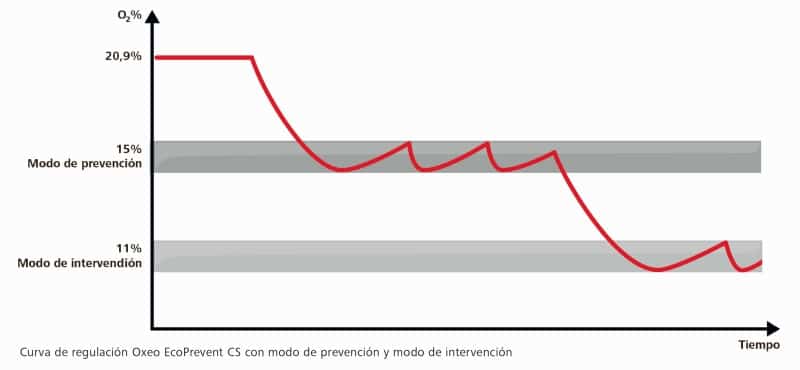
Hybrid solutions
For some projects, the fire protection solution can be individually adapted and further optimized by combining various system versions. Thus Oxeo EcoPrevent FC and VG perfectly complement each other and create an effective interplay that allows all levels of control, depending on the application. Another innovative solution for data centers is the combination of Oxeo EcoPrevent FC and CS:
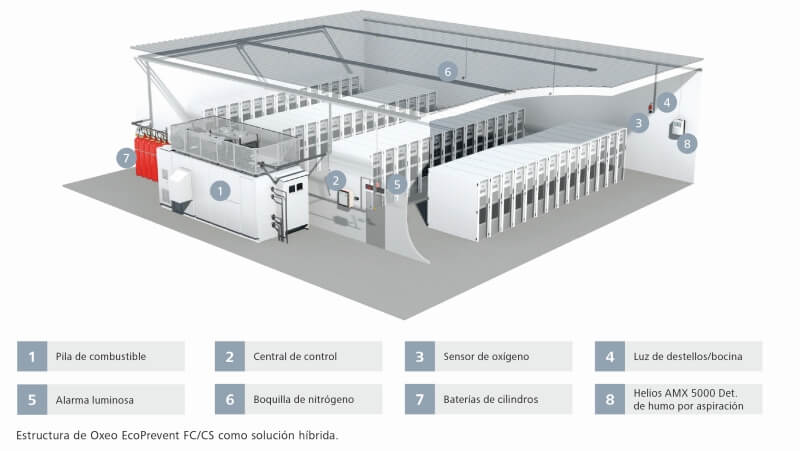
In prevention mode 1 the fuel cell keeps the oxygen content permanently in the control range of 17% vol., with the protected area remaining freely accessible.
In the event of early detection the cylinder battery is activated and in prevention mode 2 lowers the oxygen concentration to (for example) 15% vol. The concentration is kept within the control range by the use of the fuel cell and the introduction of nitrogen when required from the cylinder battery.
If the aspirating smoke detector detects aerosols or the smallest smoke particles, the system activates the intervention mode via the control panel. The cylinder battery reduces the protected area to an extinguishing atmosphere of e.g. 11% vol. and keeps this level for a predefined hold time.
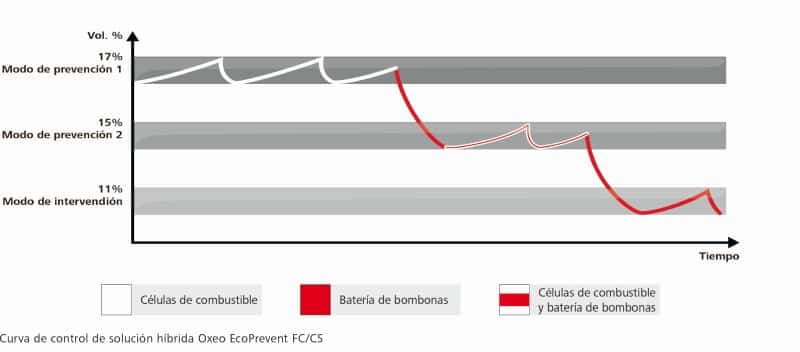
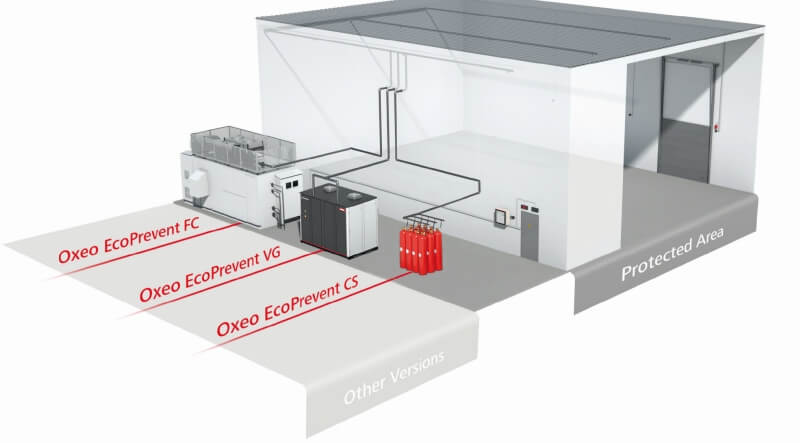
APPLICATIONS
Thanks to their different characteristics, Oxeo EcoPrevent fire prevention systems are suitable for various applications. The modularity of the system configuration allows Oxeo EcoPrevent fire prevention systems to be adapted to the relevant application.
Automated refrigerated storage and cold stores
The dry air in refrigerated storage and cold stores in particular encourages a rapid spread of fire. The insulation materials used represent a high fire load. At the same time the thick building shell creates an ideal prerequisite for the operation of a fire prevention system.
Hazardous substances warehouses and automated storage and retrieval warehouses
Fires have devastating consequences for people, the ability to deliver and the environment. The fire load is particularly high when many goods are stored in a narrow space. Fully automatic conveyor equipment creates a fire risk from possible electrical faults.
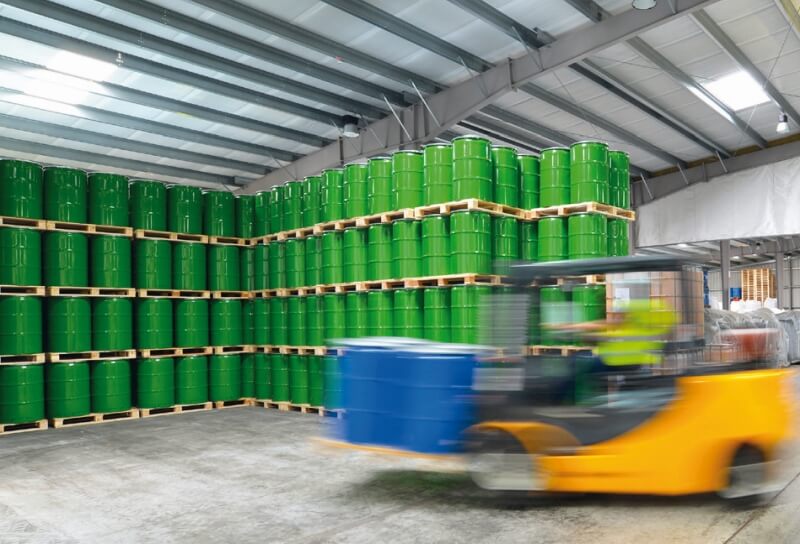
Telecommunications and information processing
High availability of IT is top priority! Overheating of the hardware or short circuits represent a significant fire risk. The high density of built-in electrical components increase this. The smallest fires, if not detected in time, can easily lead to severe damage if data is irretrievably destroyed.

Museums, safes and archives
Easily flammable materials and technical faults in devices such as the motors of electrical movable racks can be the cause of a serious fire. Unique irretrievable cultural or scientific treasures are then often destroyed.
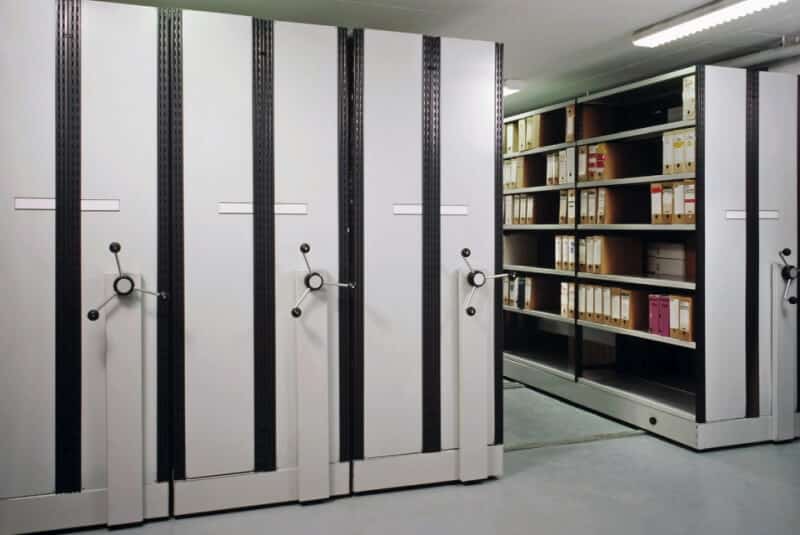
ADVANTAGES / QUALITY
There are many reasons for Oxeo EcoPrevent fire prevention systems:
- Fire cannot occur at all
- Interruptions to business are minimized
- No consequential loss through heavy production of smoke, short circuits or extinguishing agents
- Accessibility of the protected areas remains possible
- Nitrogen feed allows flexible and independent use of the protected area
- Economical and particularly effective fire protection solution via innovative nitrogen suppliers
- Environmentally friendly, since no fire debris or contaminated extinguishing agent residues need to be disposed of.
Quality through certification
The high level of reliability of the total system is guaranteed by taking into account VdS planning- and installation guidelines and the current DIN EN 16750 standard.
Oxeo EcoPrevent fire prevention systems are VdS-certified! Minimax is a VdS-certified authorized distributor for oxygen reduction systems!
